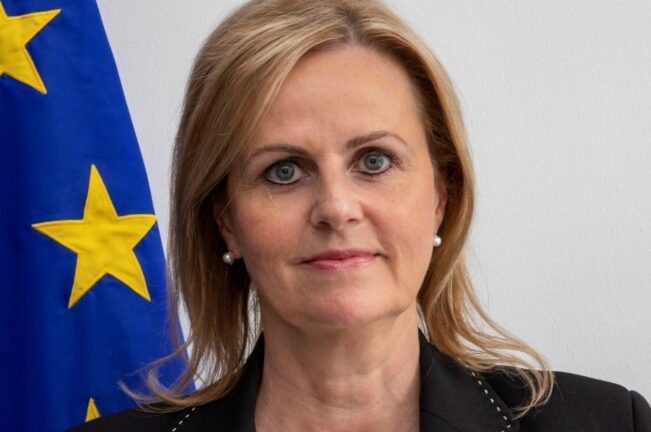Determined not to repeat the chaos of Covid-19, the European Union is keeping its vaccine engine running between crises. The blueprint links Europe’s vaccine research hub with a network of factories and a new financing approach. It promises to turn pandemic readiness into permanent capacity.
When the next pandemic strikes, Europe must not be caught off guard as it was in the case of Covid-19. “You cannot have only vaccine development; you need also the manufacturing capacity,” Florika Fink-Höijer, Director-General of HERA told the European Parliament recently. “Otherwise, in case of need, we will not have it available. And that was one of the issues we had with Covid-19.”
Inside the hub
Speaking at a recent event on the future of vaccines in Europe, the Union’s medical emergency go-to person said the new €100m European Vaccines Hub (EVH) aims to strengthen “the whole chain of countermeasures — vaccines, diagnostics and therapeutics”.
The European Vaccines Hub, financed through Horizon Europe and EU4Health, brings together leading European researchers and producers. It forms a decentralised network capable of designing vaccines within four months of a pathogen’s genomic sequence.
Using prototype platforms such as mRNA, viral vectors, recombinant proteins, and monoclonal antibodies, the Hub covers the entire development chain from preclinical studies to Phase I/II and clinical trials. Each partner anchors a national network of clinical and manufacturing sites. Together, they provide access to GMP-grade production, immunomonitoring laboratories, and rapid tech-transfer capacity with industry.
You might be interested
Industry alignment and innovation
As Ms Fink-Hooijer put it, “we have to be getting into preparedness. This means preparing now for new vaccines, for new manufacturing capacity, so as not to get caught off guard again. I always say that with all our actions, we are buying more time,” she added. “It’s not that everything will be ready, but we are probably better prepared than we ever were.”
Industry leaders at the event echoed HERA’s call for renewed ambition in Europe’s vaccine ecosystem. Jean-François Toussaint, Global Head of Vaccine R&D at Sanofi, described the current moment as “the start of a new vaccine revolution. Today we get to see that vaccines can do much more than what we thought in the past,” he said. “We at Sanofi are mindful of this opportunity, and that’s why over the past few years we’ve doubled our investment in vaccine research.”
Event host MEP Billy Kelleher (Renew/IRL), said Europe must ensure that innovation is matched by policy readiness. “We have to get to a stage where Europe is seen as a place that encourages innovation and embraces the latest technologies. And equally has a very rapid, streamlined reimbursement system in place,” he said.
Permanent manufacturing capacity
If the vaccines hub is the EU’s R&D arm, its industrial backbone is EU FAB. It provides a network of manufacturing facilities that can be activated in an emergency.
“EU FAB allows us now to produce 325 million vaccines in case of need,” Ms Fink-Hooijer explained. “That’s quite a high number of doses, but we need to keep that ever-more facility warm. Otherwise, in case of, we will not have it available. And that was also one of the issues we had in Covid-19.”
You cannot have only vaccine development; you need also the manufacturing capacity. — Florika Fink-Höijer, Director-General of HERA
Keeping those facilities operational between crises, or “warm,” as she put it, marks a deliberate shift from reactive pandemic management to continuous preparedness.
A new kind of financing
Ms Fink-Hooijer also described how HERA is expanding its collaboration with the European Investment Bank (EIB) to help fund Europe’s vaccine infrastructure.
“We go into policy equity funding,” she said. “That’s something almost nobody at national level does. And we do. HERA invests together with the EIB. We provide loans and guarantees, and they scale up what we give. Let’s say a few hundred millions, they scale up much more. And they can get philanthropists potentially in, so we have an even higher leverage.”
She underlined that maintaining readiness requires sustained investment. “From whatever angle you come, research is expensive,” she admitted. “Ever-forming capacities are expensive. But not being prepared might be even more expensive.”
A broader definition of preparedness
HERA’s scope now extends well beyond pandemic viruses. Ms Fink-Hooijer described antimicrobial resistance (AMR) as “a side of the pandemic”, noting that it kills more Europeans each year than HIV, tuberculosis and influenza combined. She also warned of the spread of climate-driven vector diseases such as chikungunya and dengue, which are now appearing in southern Europe.
Ever-forming capacities are expensive. But not being prepared might be even more expensive. — Florika Fink-Höijer
Her global perspective was clear: “Respiratory infections travel from Europe to Africa; vector-borne viruses travel from Africa to Europe,” she said. “We have to cater for both sides because everything spreads quickly in an interconnected world.” This framing places Europe’s vaccine capacity within a broader global health architecture.
Ms Fink-Hooijer devoted part of her remarks to vaccine misinformation, calling it “a threat to our health’s robustness”. She said the issue would be addressed through Commission President Ursula von der Leyen’s Global Health Resilience Initiative, linking public trust directly to preparedness policy. The initiative, announced in von der Leyen’s 2025 State of the Union address, is intended to consolidate Europe’s global health leadership and strengthen resilience beyond the EU’s borders, though the scope, budget and implementation remain unclear.





